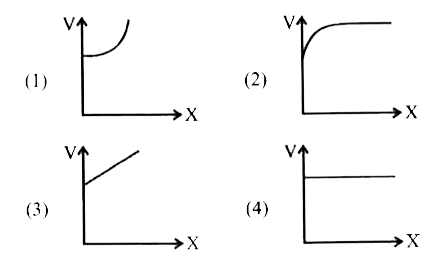The example the plates ofa parallel plate capacitor is 0.05 m. A field 3×104V/m is established between the plates. It is then disconnected from the battery and an unchanged metal plate of thicnkness 0.01 m is inserted into the capacitor parallel to its plates. FInd the potential difference between the plates (a) before the introducing of the metal plate and (b) after it introduction. What would be the potential difference if a plate of dielectric constant K = 2 is introduced in plane of metal plate ?
In case of a capacitor as E= (V/d). The potential difference between the plates before the introduction of metal plat
V=E×d=3×104×0.05=1.5KV
(b) Now as after charging is removed, capacitor is isolated so q = constant. If C and V. are the capacity and potential after the introducing of plate.
q = CV = C.V. i.e., V.=CC.V
C=ε0AdandC.ε0A(d−t)+(t/k)
V=[(d−t)+(t/k)]d×V
So, in case of metl plate as K =∞
VM=[d−1d]×V=[0.05×−0.010.05]×1.5=1.2kV
And if instead of metal plate, dieletric with K= 2 introduced.
VD=[(0.05−0.01)+(0.01/2)0.05]×1.5=1.35kV
Similar Questions
The distance between the plates of a parallel plate capacitor is "4cm" .An electric field of 2×104V/m is established between the plates.It is then disconnected from the battery and an uncharged metal plate of thickness "1cm" is inserted into the capacitor parallel to it's plates.The potential difference between the plates of capacitor after the introduction of the metal plate is k×102V .The value of ' "k" s
View SolutionThe distance between the plates of a parallel plate capacitor is 0.04m A field of 5000V/m is established between the plates and an unchanged metal plate of thickness 0.01m is inserted intothe condenser parallel to its plate. Find the p.d. between the plates (a) before the introducing of the metal plate and (b) after its introduction. what would be the p.d. if plate of dielectric constant K=2 is introduced in place of metal plate?
View Solution
Knowledge Check
Between the plates of a parallel plate capacitor a dielectric plate in introduced just to fill the complete space between the plates. The capacitor is charged and later disconnected from the battery. The dielectric plate is then slowly drawn out of the capacitor plates. the plot of the potential difference across the plates and the length of the dielectric plate drawn out is
 A
A B
B C
C D
D
A parallel plate capacitor has an electric field of 105V/m between the plates. If the charge on the capacitor plate is 1μC, the force on each capacitor plate is
A0.5 NB0.05 NC0.005 ND5 N
The distance between the plates of a parallel plate capacitor is 0.04m A field of 5000V/m is established between the plates and an unchanged metal plate of thickness 0.01m is inserted intothe condenser parallel to its plate. Find the p.d. between the plates (a) before the introducing of the metal plate and (b) after its introduction. what would be the p.d. if plate of dielectric constant K=2 is introduced in place of metal plate?
View SolutionThe' distance between the plates of a parallel plate capacitor is d. A metal plate of thickness d/2 is placed between the plates. What will e its effect on the capacitance.
View SolutionThe' distance between the plates of a parallel plate capacitor is d. A metal plate of thickness d/2 is placed between the plates. What will e its effect on the capacitance.
View SolutionAn electric field E0=3×104Vm−1 is established between the plates 0.05m apart, of a parallel plate capacitor. After removing the charging battery, an uncharged metal plate of thickness t=0.1m is inserted between capacitor plates. Find the p.d. across the capacitor, (i) before (ii) after the indroduction of plates (iii) what would be the p.d if a dielectric slab (K=2) were inroduced of place of metal plate.
View SolutionBetween the plates of a parallel plate capacitor a dielectric plate in introduced just to fill the complete space between the plates. The capacitor is charged and later disconnected from the battery. The dielectric plate is then slowly drawn out of the capacitor plates. the plot of the potential difference across the plates and the length of the dielectric plate drawn out is

View SolutionA parallel plate capacitor has an electric field of 105V/m between the plates. If the charge on the capacitor plate is 1μC, then force on each capacitor plate is-
View Solution
